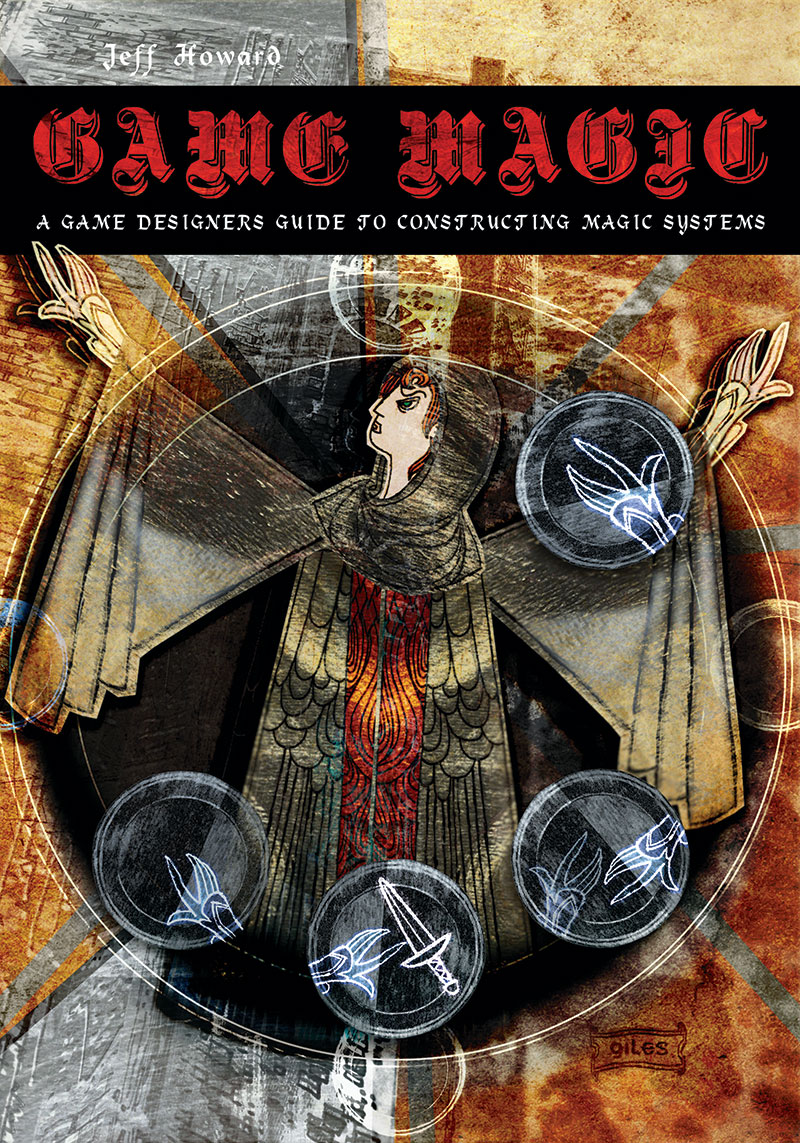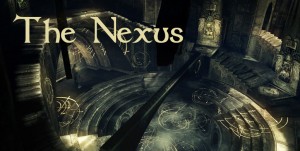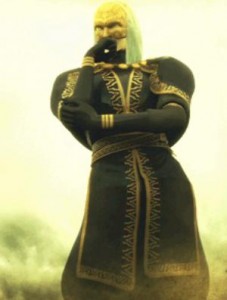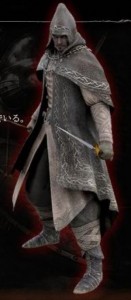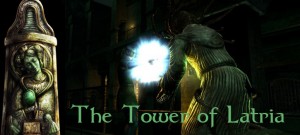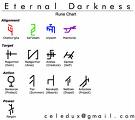My book, Game Magic: A Game Designer’s Guide to Constructing Magic Systems, is forthcoming in April 2014. I submitted the manuscript on September 1st of this year, and it is now being copyedited and typeset. The book can be preordered at Amazon. The excellent cover art below is from Giles Timms, more of whose work can be seen here.
Tag Archives: magic systems
Game Magic (Looking for Image Sources, Post # 2)
One of the topics at the heart of my forthcoming book, Game Magic, is the underlying logical flow of a magic system. Developing a magic system requires the designer to be able to express precisely the sequence of processes that a player must perform to cast a spell. Does the player need ingredients to cast a spell? Do they perform gestures or recite incantations? Will the spell draw energy from a mana pool? What happens if the player overspends mana? The answers to all of these questions can often be most effectively represented in a flow chart, which displays visually the branching logic, feedback loops, and input-output relationships of a complex system.
The two images below are excellent examples of flowcharts that clearly communicate the complex, sophisticated, and flexible logic of spellcasting in the tabletop role-playing game Mage: The Awakening (part of White Wolf’s World of Darkness universe). I would love to reproduce these charts in my book. The only problem is, I can’t find contact information for the charts’ creators. True to the mysterious universe of World of Darkness, these authors have disappeared in a labyrinth of dead links and untraceable aliases.
Here are the clues that I have. A credit on the first chart reads, “This chart was created by Angelus Michaels of Morningstar Studios. It is available on Liber Noctus. and copies found elsewhere are taken without permission. www.geniocracy.net/libernotus.ht” Liber Noctus appears to have been a fan site for World of Darkness, but its host domain (geniocracy) now directs to a Raelian website. (The Raelians are a religion based on belief in UFO’s. While they are right at home in this trail of clues, they have nothing to do with the Mage chart. These are not the droids I’m looking for).
Searches for Angelus Michaels and Morningstar Studios are equally fruitless, despite the intriguing Luciferian reference in Morningstar.
The plot thickens with a second, remastered version of the chart. The credit on this version reads “Original Flowchart by Angelica M. of Morningstar Studios. Flowchart remastered and remade by Dianna. A.V.” The chart is visually crisper and easier to read, but the trail of its origins is murkier. Angelus Michaels has become Angelica M. The mysterious figure Dianna has been introduced, evoking echoes of Agent Dale Cooper’s tape recorder, followed by the abbreviation “A.V.” Are these the initials of a username or alias? A Latin abbreviation? An allusion to the WoD universe? I’m not sure.
At any rate, I would love to use these flowcharts in my book. They are great illustrations of rigorously representing the logic of a complex magic system. But I don’t have contact information for either Angelus Michaels/Angelica M. or Dianna. There are a few forum threads that link to these charts, so I will continue to investigate through those channels, as well as doing more web research. But, if you are one of the creators of these charts, or you have an idea as to how they could be contacted, please post a comment and let me know. Thanks!
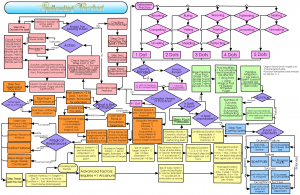
Arcana Manor: A Ceremonial Magick Simulator
Arcana Manor: A Ceremonial Magick Simulator
Arcana Manor is a game-in-progress that features a magic system in which players cast spells through a symbolic language of syllables, gems, and cards. Players control Arcana Manor through input processed by various alternative controllers, including the Kinect and the Emotiv EEG headset. My goal in Arcana Manor is to create an immersive magic system that lets players feel like they are casting spells through their mastery of arcane correspondences, expressed with ritual authenticity through gesture, word, color, and thought itself.
This footage showcases the following features
1) Two flash-based interfaces, consisting of
a) An interactive kabbalistic tree of life with ten sephiroth and twenty-two paths on which players can place tarot cards, gems, and letters from the Enochian angelic alphabet of John Dee. Placing elements according to a matrix of correspondences yields multimodal feedback as paths light up with appropriate colors and emanate musical tones derived from traditional occultist attributions.
b) An interface for recognizing magical gestures or sigils, based on Didier Brun’s Actionscript 3.0 gesture recognition library.
2) A 3d environment built in the Unity game engine, representing a magician’s temple viewed from immersive first-person perspective. The temple contains ritual implements—including an altar, a skull, swords, and pantacles— that can be used to help cast spells.
3) A Kinect interface that allows players (who have prepared themselves with rituals through the other interfaces) to summon and control the movements of a demon within his summoning triangle.
Arcana Manor is a work in progress that I have been developing interatively over the past three years through several prototypes in various engines and tools, including the Torque Game Engine Advanced, Flash, and UDK. The current build consists of a combination of Unity 3d, Flash, and the Kinect. More footage and details will follow soon.
What profiteth it a man if he gains the world and loses his soul(s)?: Reflections on Demon’s Souls
Demon’s Souls is a dark, mysterious opera whose theme, expressed through gameplay and the unfolding of a powerful narrative, is the lure and peril of Faustian bargains. By opera I refer not just to the game’s occasional bursts of swelling sound, or even to solely to its understated yet epic narrative. Rather, I use the term in the same way that Richard Wagner envisioned an ideal future form of opera as “gesamkundstwerk” or “total artwork,” in which every aspect of music, libretto, costuming, and set design fused together to create an interactive, participatory mythology.
Demon’s Souls strikes me as operatic both in its overarching structure and its minute details; I first noticed this aspect of the game when looking at the loading screens between the game’s areas. These screens are a joy to pore over, as they provide larger-than-life full portraits of the game’s various characters, each dressed in some variation of black and gold. The characters’ costumes, lovingly rendered with the lush visual textures made possible by the PS3’s high-end graphics capabilities, look more like opera costumes than the typical orcs-and-elves garb. And, as in the best opera, these details contribute to a larger aesthetic and thematic end that manifests partially in the game’s black and gold color scheme. From the first moment in the Nexus, the game’s central quest hub, the shining obsidian walls glow with overlapping layers of golden sigils right out of some arcane grimoire. As we discover through the game’s hard-won fragments of narrative reward, gold is the color of demonic magic or “soul arts” in the fallen kingdom of Boletaria. This visual symbolism lends a dark edge to one character’s reminder to the player: “you have a heart of gold . . . don’t let them take it from you.”
Many aspects of the game resonate to the tune of an overriding aesthetic principle, expressed in disparate parts working together. This principle takes the form of a question, which might be formulated with the Biblical question “what profiteth it a man if he gains the world and loses his soul?” In the case of this game, the “soul” of the verse might be better modified to “souls,” since the demon’s souls of the title are the currency of exchange in Boletaria and the only way of increasing stats, leveling up, buying items, and acquiring spells. Demon’s Souls is an arduously, unrelentingly difficult dungeon crawl in which success is possible only through the tireless trial-and-error of multiple deaths and the careful cultivation of community knowledge and cooperation. Other reviews, such as those of Michael Abbott (a.ka. the Brain Gamer) and Gamasutra, have offered excellent analyses of the game’s innovative online features and their close relationship to game’s educational element. I’ve also briefly written about some of these features in comparison and contrast to other online games in an interview with Randolph Carter at grindingtovalhalla.com.
In this entry, I’m less concerned with these features and more with a resulting experience of gameplay: the experience of temptation. While Demon’s Souls is unquestionably a game that challenges, it is also a game that tempts. Because each new corridor and secret passage bristles with difficult-to-reach exotic treasures and haunting encounters, the game constantly teases the player with the dilemma of continuing onward to fresh challenges, or retreating while one still can with one’s stock of souls. One misstep sends an unwary player back to the very beginning of a level and strips her of all unspent souls, creating a very powerful and excruciating form of negative reinforcement. One often knows, naggingly, in the back of one’s brain, that discretion is the better part of valor, that one should stop while one is ahead and cut one’s losses by returning to the Nexus after accumulating any sizable chunk of souls. Yet, the game quietly whispers in one’s ear: “come on, go just a little further, there are untold wonders around that corner.” More often than not, listening to that voice, to the suave devil on one’s shoulder, leads to the disaster of losing one’s souls.
And that is the classic Faustian bargain: recklessly seeking power and knowledge at the price of the most precious spiritual essence. The game quietly but insistently reminds players that such bargains are by their very nature losing games in which even apparent success can be as damning as failure. When one does efficiently spend souls, one can gain tangible power—power in some cases so great, as in the high-level spells earned through defeating a Greater Demon, that it intoxicates. Yet, the wisdom of this method of gaining power through the harvesting of souls (sometimes of demons and sometimes of their wretched, addled victims), seems dubious at best. Soul exchange is especially risky given the backstory element that Boletaria was corrupted, and the archdemonic Old One awakened, through the use of Soul Arts. There doesn’t seem to be much escape from Soul Arts for, while a pious priest condemns the use of magic as demonic, and his magician counterpart preaches the glories of humanistic progress over binding superstitions, both magical and priestly arts involve trading in souls. As Matthew Weise has pointed out, there are subtle but strong metaphysical implications in the game systems, through dialogue and other clues, that magic and orthodox religion are both highly similar in their methods and moral (or immoral) valuation. They are also both equally useful from a gameplay standpoint: priestly miracles serve the standard healing and protective functions, while magic provides a variety of offensive and defensive effects.
(On a sidenote, the priest’s self-righteous, monotheistic glorification of the “God of this world” at the expense of other spiritual traditions evokes a mistrust in me that no doubt comes from many places, including a background in some Gnostic traditions, in which the apparent god of the visible world turns out to be synonymous with the demonic Archon. I’m anticipating a Lovecraftian switcheroo in which the priest turns out to be worshipping the Old One. I also notice slight implications that religion and solipsism may be mildly intertwined with each other, since the most costly Banish “miracle” allows players to negate the PvP aspect of the game, driving off the Black Phantoms of other players.)
However, I’m also fairly sure that, despite my class decision to be primarily a magician who totes a miracle talisman in his left hand as a healing insurance policy, the more esoteric and humanistic ambitions of Sage Freke the Visionary are just as dangerous and reckless; the exchange of souls for magical power is, after all, the classic Faustian bargain. Even if a fighter-class player managed to avoid the lure of both talisman and wand, religion and magic, he would still have to level up. And every attempt to level is accompanied by a haunting question from the Maiden in Black, the game’s central quest-giver: “Dost thou seek Soul Power? Then touch the Demon inside me.” Based on observations of other characters, major and minor, who have had congress with demons, the results don’t seem pretty. The presence of a character named Mephistopheles in a loading screen (I haven’t encountered him yet) suggests that these Faustian parallels are quite intentional and self-aware on the part of the developers at From Software. How deep or sophisticated these intentions ultimately go is less important to me than the way that insinuations and implications emerge from the synergistic fusion of the game’s mechanics, aesthetics, and narrative, from the single-player and social interactions that develop from the game’s intricate and beautifully, if somewhat sadistically, balanced systems.
I haven’t finished Demon’s Souls (I’m 59 hours in, not counting 10 hours spent on an abortive character), but I’m going to go ahead and make a statement that I’ve been mulling over for a while now, reluctant to seem rash or fanboyish. Demon’s Souls may be the best game I have ever played. (There is still a bit of a running competition with my other favorite game, Eternal Darkness: Sanity’s Requiem, which remains an example of top-notch design that may even bear some aesthetic and gameplay resemblance to Demon’s Souls.) Each (comparatively rare) time I progress in Demon’s Souls, new mysteries open up, and these narrative discoveries are buoyed up by the inherent pleasures of persistent challenge, intermittent reward, and aesthetic gorgeousness.
(Possible spoiler alert): Last week, at the gloriously and disturbingly nightmarish second portion of the Tower of Latria, I suspected that Demon’s Souls may have finally reached the threshold of my expectations for inspired level design. Last night, during an unexpected sequence that resulted from a mysterious narrative backfiring of the now-routine attempt to summon a co-op player or Blue Phantom, I became pretty sure that this is a game like no other. I can’t describe the sequence without entering full spoilerdom, but I will say it involved a room full of chairs and a large orange turban.
It is a testament to the design of this game that it can both inspire enthusiastic accolades and a cautious reluctance—the feeling of falling into a trap, a metaphysical and moral conundrum that insidiously creeps up on unwitting players and then pounces, to a soundtrack of blaring brass and sweeping strings. Like the voice of a demon. Like the sound of an opera.
A few theoretical thoughts about magic systems, allegory, programming
I don’t think about theory much these days, focusing more on creative projects. For the last couple of days I’ve been doing some preparation for my classical myth and media class, which sparked a few theoretical thoughts. Also, I’m continuing to think about magic systems, inspired in part by a podcast ( on which Roger Travis graciously invited me to be a guest) about this subject and its relation to Arcana Manor. Magic systems have become the focus of my creative design work and my research, and I tend to think about them through the lens of interactive or procedural allegory, a system of expressive rules.
This will make more sense to readers (hopefully) when the podcast is posted.
A magic system is a set of core mechanics (spell-casting is one of them, maybe the primary one) for simulating supernatural powers and abilities rigorously and symbolically.
Quests, because of their relationship to narrative, tend to be scripted within an engine through quest flags and state changes.
Magic systems can be partially scripted within an engine (depending on the engine’s flexibility), but truly innovative mechanics have to be programmed. New mechanics tend to require, at the very least, modifications to an engine’s source code and may require the development of new engines (or at least sub-systems within an engine).
What matters to me is allegory as system, as organized matrix of rules for generating symbolic meanings. This is distinct from a linear procession of symbols (i.e. narrative) or from free-floating pool of symbols merging into each other (collective unconscious, dream). In linear mediums, allegory manifests itself as narrative (although I wonder if poetry, in its capturing of de-contextualized images, may be allegorical without being solely or even primarily narrative). Rimbaud’s Vowels or Baudelaire’s Correspondences are dense symbols without narratives. Dante’s Divine Comedy does chronicle the adventures of one pilgrim (Dante) through Hell, Purgatory, and Heaven, but the descriptive focus of the poem is the spatial organization of these realms and their inhabitants. The afterlife is a cosmological system for representing the punishment of sin and the rewarding of virtue.
A mythology (whether real as with the Ancient Greeks or invented as in the Cthulhu Mythos) is a system (a pantheon, a set of places, artifacts, recurrent events, themes). Many narratives can occur within a mythos, but many systems can also be generated by a mythology. When I was thinking about quests, I was trying to connect narrative and system, to explore their generative interplay. As I think about magic systems, I am more and more concerned with dynamic, procedural systems, which can be expressive in interactive, procedural, re-configurable ways.
Ritual is a key middle term. Ritual is enacted myth, enacted symbolism.
Eric Zimmerman says that there is magic in games but argues that this magic is the thrill of creativity and problem-solving, which are distinct in his mind from a mage’s 8th-level fireball spell or the mystical experiences of organized religion.
I don’t see these three aspects of magic as inevitably distinct. There are all sorts of connections to be woven between them.
That’s why I have a Clive Barker quotation above my desk, which in condensed form says “magic is the first and last of the world’s religions: a religion whose profoundest ritual is play.” The quotation is longer but would require a detailed gloss to do it justice, because the idea is too important for me to treat lightly. But the main point is that in Barker’s mind the three aspects of magic in games are intertwined expressions of one another. (And he puts his money where his mouth is, since this quotation is from the introduction to his Imajica collectible card game, and he has also discussed the metaphysical implications of the magic system in Undying. Incidentally, the magic system in Undying may be my second favorite magic system, just beneath Eternal Darkness.)
(A sidenote on Jung: Jung coopts the concept of the symbol for psychoanalytic purposes, but the term comes to prominence in Western thought in Romanticism (English, German, French), which precedes Jung chronologically. (e.g. Coleridge, Baudelaire, Rimbaud, Nerval). In the game Eternal Darkness, the narrator invokes Jung, Freud, and Skinner as possible correspondences to the three Ancients, but then dismisses these psychoanalysts as inadequate to the horror and majesty of the beings represented by the runes. This is a nice way of suggesting that, while Jung is a key figure in understanding symbols, their content and operation eludes his unitarian and trans-historical attempts to explain all symbols as products of a psychoanalytic entity (the collective unconscious) which he invented. A theoretical entity which originates in his own German Romanticist/early modernist context and his Freudian training.)
And allegory precedes Jung also (Plato, Spenser, Dante).
I need to read Angus Fletcher’s Allegory: Theory of a Symbolic Mode.
Question for further research: what are some of the most innovative magic systems, both in terms of mode of spell-casting, effects, and symbolism?
Mage: The Ascension and Mage: The Awakening (tabletop)
Magic: The Gathering (cardgame)
Betrayal at Krondor (crpg)
Arx Fatalis (crpg)
Loom (Adventure Game)
Eternal Darkness: Sanity’s Requiem
Color Symbolism, Magic Systems, and other Arcana Manor thoughts
Some rough conceptual notes on Arcana Manor: I’ll illustrate them and provide screenshots, links, and notes later. For now, here are the ideas that have been percolating while I’ve been working in Torque and XSI (more screenshots soon).
The magic system of Arcana Manor will be deeply tied up with symbolic color. The system at its heart will be gestural, involving the tracing of geometric figures such as pentagrams and hexagrams using the wand, sword, pentacle, and cup, with precedents in Molyneux’s Black and White as well as Arcane Studio’s Arx Fatalis. But the sigils and figures that players trace will consist of burning, glowing light whose colors constitute a systematic language. I want these colors to be as wild and intense as possible given today’s hardware: violets so deep and burning that they seem to verge on ultraviolet, scarlets so fierce that they leave marks on your retinas. Not every aspect of the project can look good technically, but the magic system should. If I weren’t worried about excessive terminology, I’d call this system “chromomancy”: “chromo” for color and “mancy” for “speaking,” as in necromancy.
(On a side note, there are technical special effects packages, such as Arcane FX, that could be modified to work with a Torque-based game with a vivid magic system. The designers of Arcane FX are already halfway there in rejecting generic-looking spells and incorporating visual symbols of animated zodiacs, pentagrams, and smouldering summoned towers.)
(On a broader side note, Arcana Manor is now definitely a Torque-based game, not an Unreal mod. I bought the engine I’m using—Torque Game Engine Advanced– and am working in it.)
There are precedents for this type of color-based magic system in literature and gaming, and the more aware I and my art team are of it, the more effective it can be.
Color symbolism is apt in part because Arcana Manor is already tarot-based, and the tarot makes extensive use of color symbolism—so much so that the B.O.T.A., a contemporary esoteric group with roots in masonry and the Golden Dawn, publishes its tarot deck in black-and-white outlines, with instructions that initiates should color the images themselves in order to better acquaint themselves with the resonances of the images. The centrality of color to tarot work is part of why Alejandro Jodorowksy’s Holy Mountain has such a rich palette, especially in the scenes in the Alchemist’s tower, including the room with cards from the director’s own tarot deck lining the walls. If I could give two examples of the color palette I’m looking for, they would be de Chirico’s paintings and Jodorowksy’s film.
Here is a link to the Alchemist’s tower in The Holy Mountain as symbolic chamber, functioning on multiple levels
4 weapons scene in this film
http://www.youtube.com/watch?v=ik2GmeLaRm8&feature=related
Jodorowksy is actually an expert on the history of tarot, especially the Marseilles deck.
I associate surrealism with a color palette of bright, vivid shades—the kind of crimson, sapphires, and emerald hues not found in everyday life. In fact, one of the ideas that I keep returning to in terms of correspondences are colors and their symbolism. There is something about color, especially vivid color that evokes symbolism: the shades of the visible spectrum suggest the simultaneous variety and systematic division of life. In Ultima IV, each of the colors stands for a virtue, and in Eternal Darkness each Ancient and school of magic has its own color (red, green, and blue, with some added complexities hinted at through purple runes and “yellow magick” alluded to by Dyack in interviews as the suggestion of a possible sequel). These two games are the primary examples in my book, but symbolic color runs throughout other games, such as the five schools of magic and their corresponding colors in Magic: The Gathering, as well as the divisions of magic spells or “rotes” in Mage: The Ascension. The multiverse of the Planescape D & D campaigns seethes with a secret code of colors, often denoting portals between the planes, as in the color pools, portals, and curtains of the astral plane. The most exciting part of The Legacy of Kain: Defiance is imbuing the Reaver blade with elemental and other enhancements, which are tracked by a set of runes and colored dots and the bottom right portion of the interface. The more varied one’s selection of hues, the further one has progressed in the game. The whole system is beautifully set up with the colored pillars of Nosgoth in Blood Omen: The Legacy of Kain—symbolism is an emergent property, since even when Silicon Knights lost the rights to the franchise they had invented, Eidos had the basis for four sequels. Dyack says that his guild creates universes in which many stories can be told, and the capacity of his systems to keep generating
There is probably some historic basis for this idea in the poetry of the French symbolists, especially Baudelaire and Rimbaud. Baudelaire’s poem “correspondences” articulates the notion of systematic, synaesthetic linkages between sensations and ideas, perhaps in its most overt modern form. Rimbaud’s poem Vowels associates A, E, I, O, and U with colors, which some critics associate with the poet’s alchemical studies. The various stages of transmutation from iron to gold are designated with Latin color names: nigredo (black), rubedo (red) and albedo (white). Both Baudelaire’s and Rimabaud’s poems will be clues found as scrolls in the manor, and there may be an alchemical tome as well.
Other ideas:
A gigantic rubik’s cube with symbolic designs, whose solution opens doorways, provides powers, allowing players to reconfigure the game’s symbol system
This might not be a cube; it might be a weirder geometry, like the Lament Configuration of Hellraiser or the dodecahedron puzzle box that was tantalizingly alluded to but never modeled in the Infinity engine of Planescape: Torment, which relied (perhaps excessively) on text-based dialogues to solve puzzles
Parts of the manor might constitute a macro-level architectural cube or puzzle: cf. the colored, trapped rooms of Cube and the rubik’s cube 3d dungeon of the diabolically difficult wireframe CRPG, Wizardry IV: The Return of Werdna
The manor’s architecture is Gothic (besides its surreal, paradoxical Escher influences). It would be worth checking out some books on Gothic architecture, blueprints of mansions, and survival horror games that have successfully used this trope so as to figure out how to push it further. Realms of the Haunting, Eternal Darkness, Undying, Resident Evil but stranger, weirder, more labyrinthine and full of secrets (if that’s possible). This is Arcana Manor, and arcana are secrets, so hidden passageways, trap doors, pop-up staircases, trompe-de-l’oeil walls should be all-pervasive. The unfolding of secret spaces is why I played Castlevania: Symphony of the Night all the way through, twice, to get 196.7% castle completion, and why I still want to play it to 200.6% even after I’ve earned the game’s best “ending.” Come to think of it, all the Castlevania games, including the critically panned 3d versions, are an inspiration. There will be blog entries on the magnificent video clips of the Castlevania arcade game, which looks wicked, and the teaser for the 360/PS3 Castlevania that might make up for what looks like the awful Wii fighting game Castlevania: Judgement.
The enemies in my game, essential to provide combat obstacles, are demons. I want to push this aesthetic as far as it can go, and for that one model is Todd McFarlane. Nobody does demons like McFarlane: Spawn is, even ten or so years after the heyday of the comic and its excellent animated HBO series, absolutely gorgeous. The various attempts at a Spawn game have received mostly mediocre reviews for derivative Devil May Cry-style combat without the variety and grace of that series, but on one thing reviewers agree: the game looked devilishly good. While I’m at it, the hidden inspiration behind a lot of this game is Clive Barker’s cancelled Majesco title Demonik, whose premature termination after the construction of a successful alpha build is both tragic and inspiring in a back-handed way. This is the game that I most wish existed. It will get its own blog entry soon also.
Below are some of the correspondences upon which this magic system will be based. The last two columns are all important: its furthest metaphorical extent (the magician’s virtues, not exactly morally based but definitely tied into a code of imagination and belief) and its most concrete game mechanics.
The motto of this game, its “point” or one of them, might be summed up in an epigraph from Goethe’s Faust, spoken by the angels, which goes loosely: “he who ceaselessly strives, him we can save.” The redemptive side of the Faust legend.
|
|
|
|
|
|
|
|
|
|
|
|
|
|
|
|
|
|
|
|
Magic schools (obvious D & D) |
Elemental (obvious also, cf. Soul Reaver, Zelda, etc.) |
Powers of a Magician (Levi, Crowley Jodorowksy) |
How the metaphor plays out in gameplay |
|
Wand |
Alterative |
Fire |
Willing |
Re-shaping an environment (freezing water, raising platforms) |
|
Cup |
Restorative |
Water |
Knowing |
Mastering a body of symbols, gestures, maps |
|
Sword |
Aggressive |
Air |
Daring |
Conjuring and facing demons Overcoming obstacles (high chasms and abysses) |
|
Pentacle |
Protective |
Earth |
Keeping Silence |
Not being overly chatty with deceptive or distracting NPC’s Keeping Knossos’ secrets safe |
|
|
|
|
|
|
|
|
|
|
|
|
Cf. Dante’s fourfold allegory
I’ll start working on a GUI for the magic system soon, since the Torque engine allows for as much custom interface design as the designer can program.
Magic Systems and Meaningful Scripting
One of my next projects will be an article comparing the magic systems of various games, both conceptually and in terms of their underlying quantitative mechanics, as one example of how interactive symbolism can be programmed. As readers of Quests know, I regard programming as a form of procedural, interactive writing, which unfolds according to a set of rules that both constrain and facilitate player actions and interpretations. For example, the magic systems of role-playing games (tabletop, single-player, and MMO) comprise rigorous, quantitative rules for altering the physical and sometimes mental reality of a particular game world. Because these systems often involve glyphs, runes, and incantations, there are opportunities to encode meaning into a core game mechanic, as in the tabletop game Mage: The Awakening or the elaborate cosmology of Eternal Darkness.
Questions for research include:
- How have different table-top RPG’s, CRPG’S, action-adventure games, and MMO’s implemented magic systems?
- What are the origins of magic systems in fantasy novels? For example, the convention of having magic users memorize spells that are then erased from their memory after being cast derives from Fritz Leiber, but not from Tolkien (who eschewed direct references to the concept of magic in his work).
- What is the relationship between game systems of magic and real occultist systems? (This treads on difficult ground, because of many gamers’ understandable discomfort with the association by fundamentalists of Dungeons and Dragons with black magic. However, Gary Gygax himself encouraged dungeon masters to consult encyclopedias of the occult as reference works, and Silicon Knights did thorough research into actual historical arcane systems in order to build the elaborate spell-casting system of Eternal Darkness. The table-top role-playing systems Nephilim and Mage: The Awakening both embrace mystical lore as metaphors explored through their game mechanics.)
- Most importantly, as relates to programming practice:
- How did the World of Darkness mod (WoDMod) script the magic system of the Mage tabletop game into Vampire: The Masquerade Redemption?
- How do custom NWN scripters make their own spells?
- How could we as designers learn from past design of magic systems in order to make our own games’ magic systems both more fun and metaphorically resonant, so that we invest this aspect of fantasy with all its potential for symbolism rather than reducing it to the glitz and glamor of flashy visual effects without substance?
